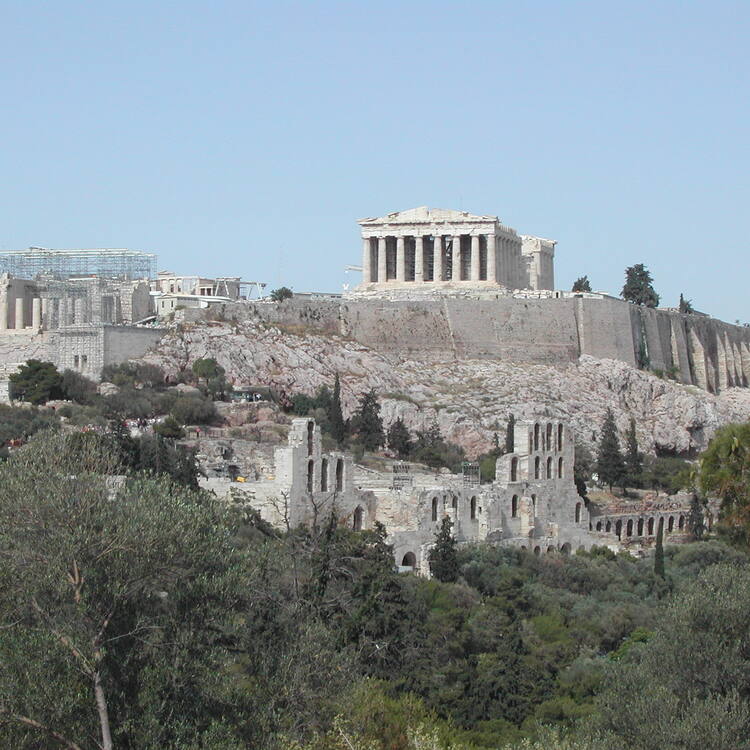Acropolis, Athens
Acropolis, Athens
The Acropolis of Athens and its monuments are universal symbols of the classical spirit and civilization and form the greatest architectural and artistic complex bequeathed by Greek Antiquity to the world. In the second half of the fifth century bc, Athens, following the victory against the Persians and the establishment of democracy, took a leading position amongst the other city-states of the ancient world. In the age that followed, as thought and art flourished, an exceptional group of artists put into effect the ambitious plans of Athenian statesman Pericles and, under the inspired guidance of the sculptor Pheidias, transformed the rocky hill into a unique monument of thought and the arts. The most important monuments were built during that time: the Parthenon, built by Ictinus, the Erechtheon, the Propylaea, the monumental entrance to the Acropolis, designed by Mnesicles and the small temple Athena Nike.
Description is available under license CC-BY-SA IGO 3.0
Acropole d'Athènes
L'Acropole d'Athènes et ses monuments sont le symbole universel de l'esprit et de la civilisation classiques, et forment le plus extraordinaire ensemble architectural et artistique légué par la Grèce antique au reste du monde. Dans la seconde moitié du Ve siècle avant JC, Athènes, suite à sa victoire sur les Perses et à l'établissement de la démocratie, prit un ascendant sur les autres Cités-États du monde antique. Durant cette période, alors que l'art et la pensée florissaient, un groupe exceptionnel d'artistes mit en œuvre les plans ambitieux de Périclès, homme d'État athénien, et transforma, sous la direction éclairée du sculpteur Phéidias, la colline rocheuse en un monument unique d'esprit et d'arts. Les principaux monuments furent érigés à cette époque : le Parthénon, construit par Ictinus, l'Érechthéion, les Propylées, l'entrée monumentale de l'Acropole, dessinés par Mnesiclès et le petit temple d'Athéna Nikê.
Description is available under license CC-BY-SA IGO 3.0
أكروبول أثينا
يمكن اعتبار أكروبول أثينا الذي يجسد الحضارات والأساطير والأديان التي ازدهرت في اليونان منذ أكثر من ألف سنة والذي ترتفع فيه أربعة من أكبر تُحف الفن اليوناني الكلاسيكي، وهي معبد أثينا البارتينون ومدخل الأكروبول بروبيلي ومعبد أركيتون ومعبد الإلهة نيكي، عنصراً بارزاً في التراث العالمي.
source: UNESCO/CPE
Description is available under license CC-BY-SA IGO 3.0
雅典卫城
雅典卫城包括希腊古典艺术最伟大的四大杰作——帕特侬神庙、通廊、厄瑞克修姆庙和雅典娜胜利神庙,诠释了一千多年来在希腊繁荣、兴盛的文明、神话和宗教,可被视为世界遗产理念的象征。
source: UNESCO/CPE
Description is available under license CC-BY-SA IGO 3.0
Афинский Акрополь
Акрополь, содержащий напоминание о более чем тысячелетнем развитии цивилизаций, мифологии и религии, процветавших в Греции, является местом нахождения четырех величайших шедевров классического древнегреческого искусства – Парфенона, Пропилей, Эрехтейона и храма Афины Паллады, которые могут рассматриваться, как символы всемирного наследия.
source: UNESCO/CPE
Description is available under license CC-BY-SA IGO 3.0
Acrópolis de Atenas
La acrópolis de Atenas y sus monumentos son el símbolo universal de la civilización y el espíritu clásico, y forman el más extraordinario conjunto arquitectónico y artístico legado por la Grecia antigua al mundo entero. En la segunda mitad del siglo V a.C., después de su victoria en la guerra contra los persas y el establecimiento de la democracia, Atenas ocupó una posición dominante con respecto a las demás ciudades-estados de la Antigüedad. En este periodo de florecimiento del pensamiento y las artes, un grupo excepcional de artistas ejecutó los ambiciosos planes del estadista ateniense Pericles y transformó, bajo la inspirada dirección del escultor Fidias, un montículo rocoso en un monumento excepcional del arte y el espíritu. Fue en esta época cuando se erigieron los principales monumentos del sitio: el Partenón, construido por Ictino, los Propíleos, la entrada monumental de la Acrópolis diseñada por Mnesicles, el Erecteion y el pequeño templo de Atenea Niké.
source: UNESCO/CPE
Description is available under license CC-BY-SA IGO 3.0
アテネのアクロポリス
source: NFUAJ
Acropolis, Athene
Source: unesco.nl
Outstanding Universal Value
Brief synthesis
The Acropolis of Athens is the most striking and complete ancient Greek monumental complex still existing in our times. It is situated on a hill of average height (156m) that rises in the basin of Athens. Its overall dimensions are approximately 170 by 350m. The hill is rocky and steep on all sides except for the western side, and has an extensive, nearly flat top. Strong fortification walls have surrounded the summit of the Acropolis for more than 3,300 years. The first fortification wall was built during the 13th century BC, and surrounded the residence of the local Mycenaean ruler. In the 8th century BC, the Acropolis gradually acquired a religious character with the establishment of the cult of Athena, the city’s patron goddess. The sanctuary reached its peak in the archaic period (mid-6th century to early 5th century BC). In the 5th century BC, the Athenians, empowered from their victory over the Persians, carried out an ambitious building programme under the leadership of the great statesman Perikles, comprising a large number of monuments including the Parthenon, the Erechtheion, the Propylaia and the temple of Athena Nike. The monuments were developed by an exceptional group of architects (such as Iktinos, Kallikrates, Mnesikles) and sculptors (such as Pheidias, Alkamenes, Agorakritos), who transformed the rocky hill into a unique complex, which heralded the emergence of classical Greek thought and art. On this hill were born Democracy, Philosophy, Theatre, Freedom of Expression and Speech, which provide to this day the intellectual and spiritual foundation for the contemporary world and its values. The Acropolis’ monuments, having survived for almost twenty-five centuries through wars, explosions, bombardments, fires, earthquakes, sackings, interventions and alterations, have adapted to different uses and the civilizations, myths and religions that flourished in Greece through time.
Criterion (i): The Athenian Acropolis is the supreme expression of the adaptation of architecture to a natural site. This grand composition of perfectly balanced massive structures creates a monumental landscape of unique beauty, consisting of a complete series of architectural masterpieces of the 5th century BC: the Parthenon by Iktinos and Kallikrates with the collaboration of the sculptor Pheidias (447-432); the Propylaia by Mnesikles (437-432); the Temple of Athena Nike by Mnesikles and Kallikrates (427-424); and Erechtheion (421-406).
Criterion (ii): The monuments of the Athenian Acropolis have exerted an exceptional influence, not only in Greco-Roman antiquity, during which they were considered exemplary models, but also in contemporary times. Throughout the world, Neo-Classical monuments have been inspired by all the Acropolis monuments.
Criterion (iii): From myth to institutionalized cult, the Athenian Acropolis, by its precision and diversity, bears a unique testimony to the religions of ancient Greece. It is the sacred temple from which sprung fundamental legends about the city. Beginning in the 6th century BC, myths and beliefs gave rise to temples, altars and votives corresponding to an extreme diversity of cults, which have brought us the Athenian religion in all its richness and complexity. Athena was venerated as the goddess of the city (Athena Polias); as the goddess of war (Athena Promachos); as the goddess of victory (Athena Nike); as the protective goddess of crafts (Athena Ergane), etc. Most of her identities are glorified at the main temple dedicated to her, the Parthenon, the temple of the patron-goddess.
Criterion (iv): The Athenian Acropolis is an outstanding example of an architectural ensemble illustrating significant historical phases since the 16th century BC. Firstly, it was the Mycenaean Acropolis (Late Helladic civilization, 1600-1100 BC) which included the royal residence and was protected by the characteristic Mycenaean fortification. The monuments of the Acropolis are distinctly unique structures that evoke the ideals of the Classical 5th century BC and represent the apex of ancient Greek architectural development.
Criterion (vi): The Acropolis is directly and tangibly associated with events and ideas that have never faded over the course of history. Its monuments are still living testimonies of the achievements of Classical Greek politicians (e.g. Themistokles, Perikles) who lead the city to the establishment of Democracy; the thought of Athenian philosophers (e.g. Socrates, Plato, Demosthenes);and the works of architects (e.g. Iktinos, Kallikrates, Mnesikles) and artists (e.g. Pheidias, Agorakritus, Alkamenes). These monuments are the testimony of a precious part of the cultural heritage of humanity.
Integrity
The Acropolis of Athens contains within its boundaries all the key attributes that convey the property’s Outstanding Universal Value, as an ensemble of unique splendor in excellent condition. The perfection of ancient building techniques ensured the resistance of the monuments to natural forces through time. Despite the unavoidable damage of time, they still display their beauty and convey their inestimable artistic and historic value, preserving all the features that directly and tangibly associate them with the events and ideas of Democracy and Philosophy. Inevitably, the vicissitudes of history between the 5th century BC and our days have caused extensive damage that is being successfully addressed with the ongoing restoration and conservation works, which increase both the stability and the legibility of the monuments.
Authenticity
The authenticity of the Acropolis hill, crowned with the masterpieces of Greek Classical art and architecture, is well preserved. In order to maintain the authenticity and structural integrity of the monuments, an integrated intervention begun in 1975 and continues today. The works are based on clear theoretical and scholarly foundations, and follow the principles of the Venice Charter. The interventions are limited to the absolutely necessary and respect the ancient structural system, while remaining consistent with the principle of reversibility. Moreover, the techniques and the tools used for the restoration works are similar to those of the ancient craftspeople, while the white marble used for completing the eroded architectural elements is quarried from the same mountain as in antiquity (Mt. Penteli). Therefore, the restorations are fully compatible with the original parts of the monuments.
Protection and management requirements
The Acropolis has been operating as an archaeological site since 1833, shortly after the establishment of the modern Greek State. Nowadays, the property is strongly protected under the provisions of Law No 3028/2002 on the “Protection of Antiquities and Cultural Heritage in general”. Moreover, the Acropolis and its surroundings, which constitute monuments per se, are protected by legislative decrees (Ministerial Decrees F01/12970/503/25.2.82 concerning the designation of its buffer zone; and F43/7027/425/29.1.2004 concerning the designation of the peripheral zone of the city of Athens and imposing obligatory control before issuing any building or development permit within its boundaries). The fact that the property’s buffer zone is a protected archaeological area itself, along with the implementation of the strict legal framework – especially for the urban tissue in the historical centre of Athens since 2002 – and the intense monitoring by the competent Ephorate, ensure that urban development pressures are adequately addressed. Special protection is provided by the Presidential Decree No 24/2007, which declares the Acropolis area a no-fly zone.
The property is under the jurisdiction of the Ministry of Culture, Education and Religious Affairs, through the Ephorate of Antiquities of Athens, its competent Regional Service, which is responsible for the site’s security and protection, as well as the implementation of an efficient site and visitors’ management system. Moreover, the Ministry of Culture, Education and Religious Affairs implements the legislative decrees concerning the safeguarding of the property and its peripheral zone (which corresponds to the boundaries of the ancient city of Athens and its surroundings) and ensures the visual integrity of the site. Especially for the restoration, protection and monitoring of the property, an advisory body, the Committee for the Restoration and Conservation of the Acropolis Monuments, was founded in 1975 and is responsible for planning, directing and supervising the interventions. In 1999, the establishment of the Αcropolis Restoration Service allowed to increase the academic and technical personnel and made the immense development of the restoration works possible, under the supervision of the aforementioned Committee and in cooperation with the competent Ephorate. The extensive research programme and the methodology implemented are innovative in this field and act as a reference point for other restoration projects. The financial resources for the works on the site are derived from the State budget as well as from European Union funds.
Special attention has been paid to the accessibility of the site, to pathways and to visitor facilities, especially for disabled people. Furthermore, emergency plans for visitor security and scientific studies for the protection of the site, such as monitoring of earthquake activity, are being carried out.
The New Acropolis Museum (inaugurated in 2009), in which most of the original sculptural and/or architectural pieces of the monuments are conserved, the on-going project “Unification of the Archaeological Sites of Athens”, as well as the long-term conservation works will enhance the protection and the presentation of the property.

 View photos from OUR PLACE the World Heritage collection
View photos from OUR PLACE the World Heritage collection

